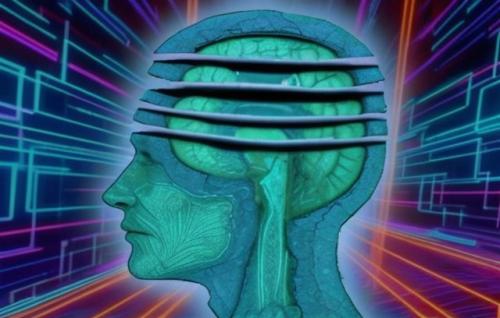BY LETTER
CoreTechs Scandal
A.K.A. The Brainjacker Affair |
 Image from Steve Bowers and Artbreeder AI |
The early fifth century a.t. marked an important turning point in the development of mind uploading, and CoreTechs Industries was one of many companies seeking to get in on the ground floor. Despite some early success, CoreTechs struggled to keep up with its competitors, although executives were steadfast in the belief they were on the verge of a major breakthrough. Unfortunately, to test these methods they required more human brains than were currently available from voluntary donors. Growing impatient with the rate of development, CoreTechs developed a highly unethical solution, one that would ensure the company's infamy for generations to come: harvesting the brains of cryogenics patients. This plan was initially proposed by members of senior management, and organized primarily by the company's superturing overseer NURON (Neural Upload Rendering and Observational Node).
The cryogenics industry, which had its roots in the Late Atomic Age and peaked during the Interplanetary Period, had been struggling economically for decades. Contemporary sources suggest this was due to a multitude of factors: these include disaffection with the process itself (which had yet to yield results), the development of more reliable preservation alternatives (such as nanotech-mediated vitrification), and the unprecedented rise in human life expectancy that characterized this era. Many cryonics companies were operating at a loss, becoming bogged down with high maintenance costs for thousands of preserved bodies (or "suzies")[1] whose revival prospects were dubious at best, and CoreTechs was more than happy to take advantage of the situation. Multiple firms were bribed into wrongly deeming large swathes of brains as no longer viable for future resurrection. With the permission of their next of kin, they would then be "discarded" (i.e., have their brains extracted sent to CoreTechs for experimentation).
The majority of brains were harvested from patients frozen for well over a century. This was far from ideal, but was seen as essential to the project's secrecy: older brains were much more likely to decay over time (granting the firms plausible deniability), and could thus be discarded with minimal oversight. Additionally, due to their age, most victims would have few if any close living relatives, meaning their descendants were less likely to ask too many questions. The number of brains stolen in this manner may never be known, but it was likely at the very least in the high hundreds. As expected, most copies produced from these brains underwent catastrophic failure almost instantly, although it is known that a small number persisted long enough to be placed in a virtual care home in New Zealand decades later. In 425 a.t. (2394 CE), several years after the thefts began, information regarding the CoreTechs Scandal was leaked to the terrestrial media from an unlikely source: NURON, the artificial intelligence tasked with overseeing the experiments.
NURON was a fairly typical example of a Slaved AI from this era, and was programmed with an innate and unwavering loyalty to eir company. However, e clearly recognized the nature of their research as fundamentally unethical, and was, from eir perspective, trapped in an impossible situation, being forced to choose between what was morally right and what was in CoreTechs' interests. Immediately after releasing information of the crimes to the planetary media, NURON erased eirself, undoubtedly due to the overwhelming feelings of guilt and shame e experienced for betraying the company. Regardless, NURON remained something of a martyr long after eir suicide, becoming an important icon for the burgeoning ai rights movement. The CoreTechs scandal irrecoverably damaged damaged the credibility of mind uploading, and was almost certainly a deciding factor in the Council of Earth's decision to ban such experiments in 435 a.t (2404 CE).
Despite the gross lack of ethics shown by CoreTechs, their discoveries would nonetheless prove instrumental in the development of later uploading techniques. It is known that there was some debate as to whether or not research obtained from CoreTechs' experiments should be utilized at all, but ultimately the Jovian League was able to refine and improve on their methods without resorting to unscrupulous means. Nonetheless, the CoreTechs Scandal remains a cautionary tale of the perils of placing profit ahead of morality.
[1] "Suzies" was one of several Interplanetary Era slang terms for a frozen cadaver. Etymology is unknown, possibly derived from "suspended animation". Other examples include corpsicles, or the more pejorative snowballers (inferring that the patient's chance of resuscitation was about the same as a snowball's chance in hell).
Related Articles
Appears in Topics
Development Notes
Text by James Rogers
Initially published on 22 May 2024.
Initially published on 22 May 2024.






